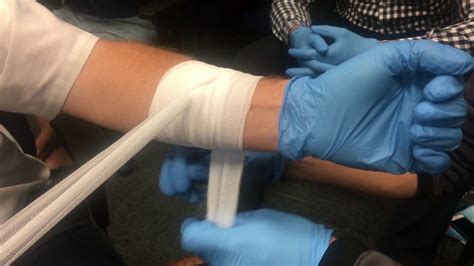How to Wrap a Gauze Around Your Armpit: A Step-by-Step Guide
Dealing with an armpit wound requires careful attention to cleanliness and proper dressing. Knowing how to correctly wrap a gauze pad around your armpit can significantly aid in healing and prevent infection. This guide provides a simple, step-by-step process. Remember, this information is for educational purposes only and does not replace professional medical advice. Always consult a doctor or healthcare professional for any wound care concerns.
Assessing Your Wound
Before you begin, carefully examine your wound. Note the size, depth, and any signs of infection such as increased redness, swelling, pus, or excessive pain. If you observe any of these signs, seek immediate medical attention.
Cleaning the Wound
Cleanliness is paramount. Before applying the gauze, gently clean the wound with a mild antiseptic solution and sterile water. Use clean cotton swabs or gauze pads to remove any dirt or debris. Avoid scrubbing, as this can irritate the wound. Pat the area dry with a clean towel or gauze.
Gathering Your Supplies
You will need the following materials:
- Sterile gauze pads: Choose a size appropriate for your wound.
- Medical tape: Hypoallergenic tape is preferable to minimize skin irritation.
- Scissors (optional): If you need to cut the gauze to fit.
- Clean gloves (recommended): To maintain hygiene and prevent infection.
Wrapping the Gauze: A Step-by-Step Process
-
Prepare the Gauze: Lay out a sterile gauze pad. If necessary, use scissors to cut it to a suitable size to comfortably cover the armpit wound without overlapping onto unaffected skin too much.
-
Apply the Gauze: Carefully position the gauze pad over the wound, ensuring complete coverage.
-
Securing the Gauze: This is where the technique varies slightly depending on the wound's location and size. You'll likely need to use a few strips of medical tape. Here are a few options:
-
Method 1 (For smaller wounds): Apply two strips of tape, one running horizontally across the top of the gauze and the other horizontally across the bottom. These strips should adhere to the skin on either side of the armpit.
-
Method 2 (For larger wounds or more support): Use multiple strips of tape, applying them in an overlapping "X" pattern to secure the gauze firmly in place.
-
Method 3 (Consider a bandage): For larger wounds or for added support and comfort, consider using a larger bandage designed for the underarm area. These are available at most pharmacies.
-
-
Checking the Application: Once the gauze is secured, gently check that it’s comfortable and doesn’t restrict movement too much. Ensure it covers the wound completely and that the tape isn't too tight, which could restrict blood flow.
-
Changing the Dressing: Change the dressing regularly, typically at least once a day, or more often if it becomes soiled or wet. Always follow your doctor's instructions for dressing changes.
When to Seek Medical Attention
- Signs of infection: Increased pain, swelling, redness, pus, or fever.
- Excessive bleeding: The wound bleeds uncontrollably.
- Wound doesn't heal: The wound shows no signs of improvement after several days.
- Severe pain: You experience significant pain despite using over-the-counter pain relievers.
By following these steps and seeking professional advice when needed, you can effectively and safely wrap a gauze pad around your armpit to promote wound healing. Remember, proper wound care is crucial for preventing complications.
